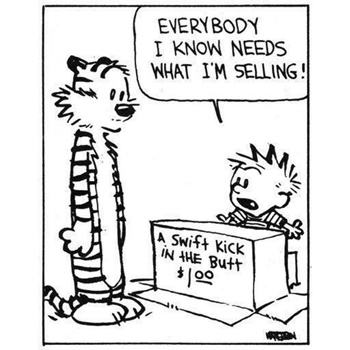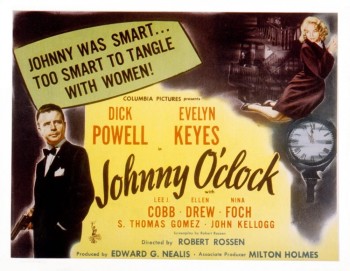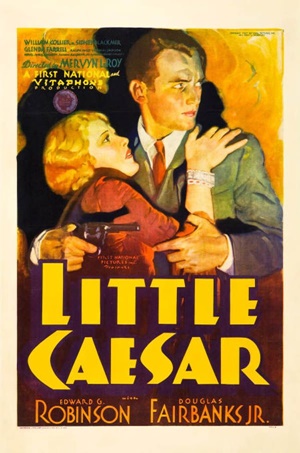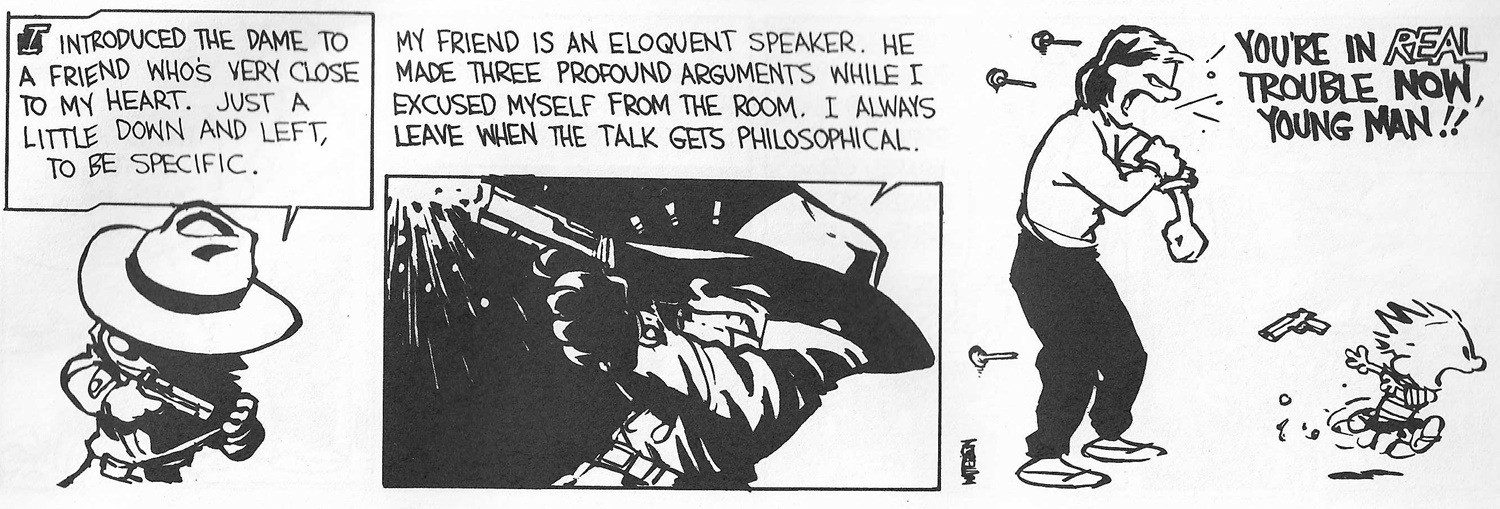A (Black) Gat in the Hand: Tracer Bullet Takes the Case
“You’re the second guy I’ve met within hours who seems to think a gat in the hand means a world by the tail.” – Phillip Marlowe in Raymond Chandler’s The Big Sleep
(Gat — Prohibition Era term for a gun. Shortened version of Gatling Gun)
I have had a Roger Torrey essay in mind for a couple years. And I thought I was going to write it this past weekend, but it didn’t quite work out that way. I’ll still be doing one this summer (he tells himself), using a short story from Black Dog’s excellent collection, Bodyguard. But today is not that day!
Calvin and Hobbes rivals Fox Trot for my all-time favorite comic strip. Bloom County barely holds off Dilbert for the third spot. Of course, the magic of C&H captivated millions over the years, and still does.
I have all of the non-repeating collections. Having bought them as they came out, I didn’t get that massive hardback collection. I even have the one from the exhibit here at Ohio State in Columbus, OH back in 1995. I didn’t see that one, unfortunately.
Calvin is a six-year old kid, and he has a stuffed tiger named Hobbes. Hobbes is alive when it’s just Calvin around. He’s a normal stuffed animal when someone else is (I only noticed one panel with an animated Hobbes, and someone else there…). Calvin is constantly getting into trouble with Hobbes.
There were some recurring characters, like Spaceman Spiff. There were two or three series’ with Calvin imagining himself as the classic hardboiled private eye, ala Sam Spade. He is Tracer Bullet.
Watterson said of the Tracer Bullets, they were “extremely time-consuming to write, so I don’t attempt them too often.” I know of two series,’ and I have vague recollections of at least a third.
In Strip One, Calvin’s long-suffering mom, comes upon a broken lamp, and an overturned table. She screams and wants to know who did it. Calvin’s parents had no proper names. Watterson explained that was because they had no purpose outside of Calvin’s life. They were simply Mom and Dad. He mentions he had brought an uncle once, and it didn’t work. He had an independent existence beyond Calvin’s world. He was dropped after the one story line.
Something broken in that household is not an uncommon event! But the third panel in the Strip opens up the story. It’s the classic hardboiled private eye scene. It’s an office, with the detective sitting in a chair, feet up on the desk, fedora hat on. Light from the window hits part of the room, but it’s dark. There’s a bottle on the desk, and some playing cards spread out. Bullet is a private dick trying to get by, but he’s not rolling in dough.
The text is heavy-handed, but more on that in the next Strip.
“The dame’s scream hit an octave usually reserved for calling dogs, but it meant I had a case, and the sound of greenbacks slapping across my palm is music to MY ears any day. After all, I’m not an opera critic. I’m a private eye.”
I roll my eyes when I see that kind of prose in a Dan Turner story (from Robert Leslie Bellem). But this is Calvin and Hobbes. It’s fun!
Three of the four panels in the next Strip are very black inked. Of course, that type of cinematography is a staple of noir films. The noir look is a very distinctive one, and Watterson does a nice job with it in the Tracer Bullets. The fourth and last panel reverts back to ‘normal,’ as Calvin’s mom confronts him. His narrative is still hardboilded, but we’re back in reality. It was the same in the first two panels of Strip One.
Watterson was not at all familiar with film noir or detective novels, so he just spoofed the cliches of the genre with Tracer Bullet. It definitely makes them fun.
“I keep two magnums in my desk. One’s a gun and I keep it loaded. The other’s a bottle, and it keeps ME loaded. I’m Tracer Bullet. I’m a professional snoop.”
There’s more of the patter in the second and third panels, before Mom shows up. Normally, the PI is impressed with the beautiful female client. That’s not gonna work with Calvin being a kid, and it being his mom. So Watterson keeps the traditional response, but makes it a kid in trouble with his mom instead. It works. LOVE his expression when she comes in his room.
The first panel brings us back into Tracer’s world. Notice the shadow, to keep the black ink look. It’s the poor gumshoe, forced to take any client he can get. Mom is shoving him to the scene of the crime with a look that isn’t good for Calvin. More Bullet prose.
Panel three has Bullet looking at the broken lamp with the comment, “Either she had a psychotic decorator, or her place had been ransacked by someone in a big hurry.” Totally vibeing the classic PI story. The Strip ends with Mom telling Calvin to explain the broken lamp. Calvin, channelling Tracer, thinks, “The dame was hysterical. Dames usually are.”
The only other Watterson comment I’ve seen related to Tracer Bullet is that he observed that “Cartoonists don’t use black much anymore (the eye, being lazy, is attracted to empty white space, especially when the panels are so small), and we miss some dramatic possibilities that way.”
The dark panels absolutely stick out from the white ones, and they certainly give the series a noir feel.
Panel one on Strip Four is classic Calvin. He tells his mom not to touch anything, as he’s looking for clues. Having raised a son through these years, I can’t imagine how exasperating being Calvin’s mom must be.
Panel Two is back in Tracer mode, and he hears a gun being cocked at the back of his head. He realizes ‘the dame’ didn’t want to solve the crime. She wanted to pin it on him. He was a patsy. Which is great classic private eye stuff. And also, in the real world, completely understandable. Calvin certainly did knock the lamp over. Probably playing with Hobbes.
As the mom glares down at him, expectantly, he prepares to go ‘Full Calvin.’
“I didn’t like the way this story was shaping up, so I decided to write a new ending with my .45 Automatic as co-author.”
This is straight out of Mickey Spillane’s Mike Hammer.
Tracer tugs on his trench coat and pulls out his (dart) gun. Love the patter in this first panel.
And then he unloads, with prose Carroll John Daly might have given Race Williams.
“My friend is an eloquent speaker. He made three profound arguments while I excused myself from the room. I always leave when the talk gets philosophical.”
We go to the final panel in Strip Five. Three darts adorn the wall; Mom has rolled up her sleeves and says, “You’re in REAL trouble now, young man”; as Calvin tosses aside his gun and runs for his life. This is hilarious. Was any classic private eye ever in more danger?
We move into the final Strip, and Watterson brings it home.
We see big arms and hands with a blackjack, ready to hammer Tracer. More great description.
Then we see Calvin sitting, getting a lecture from Dad, who got home from work to find another disaster. There are times the Dad laments his tiring job, looking forward to getting home. He doesn’t even get in the front door before he wishes he was back at the office.
“When he was done, an all-percussion symphony was playing in my my head, and the acoustics were incredible. The orchestra went on a en-city tour of my brain, and I had a season pass with front for seats.”
Again – this would be too much in an actual story. But it’s perfect for Calvin and Hobbes.
In the penultimate panel, Tracer is back at his desk. Feet up again, smoking, an opened pack, the bottle (rye, maybe?), and the classic old-style phone (I’m picturing Bogie talking to his lawyer in The Maltese Falcon.
Bullet has solved the case. But since he no longer has a client, he’s going to keep things to himself. I love the image of the private eye at his desk, a picture of solitude.
 A heavy-handed opening paragraph I wrote for a hardboiled parody I wrote of William Gillette’s curtain-raiser play, The Painful Predicament of Sherlock Holmes:
A heavy-handed opening paragraph I wrote for a hardboiled parody I wrote of William Gillette’s curtain-raiser play, The Painful Predicament of Sherlock Holmes:
“I sat in my office, watching dust motes dance in the sunlight. The slats were pulled halfway, and they made a regular pattern on the floor. Unfortunately, this was the most action the office had seen in a week. Being a shamus in this town meant dry spells in jobs, not just the weather. The phone wasn’t ringing, but I wasn’t all that certain I’d paid the bill, either. I wouldn’t need an armored truck if I withdrew my bank account. Hell, I wouldn’t even need a wallet.”
And we close it out with Calvin grounded, in his room. Still thinking as Tracer, he says the “culprit was a buddy” of his and he closes the case. Hobbes is next to him on the bed, tossing a football. And the final balloon is the tiger saying:
“I guess we should have played outside, huh?”
I think this is absolutely a gem of a series. The tropes, the prose, the dark panels – Watterson might not know noir, but he does a heck of a job drawing a Calvin and Hobbes noir strip. Everything about this works for me. Including the shifting between being in Tracer’s world, and Calvin’s real world. His poor Mom…
I have another six-panel strip, with Calvin going Tracer to solve his math quiz. Susie Derkins in that one. As you might guess, she’s not portrayed too favorably. You’ll see that one later this summer.
Prior posts in A (Black) Gat in the Hand – 2022 Series (6)
Asimov – Sci Fi Meets the Police Procedural
The Adventures of Christopher London
Weird Menace from Robert E. Howard
Spicy Adventures from Robert E. Howard
Thrilling Adventures from Robert E. Howard
Norbert Davis’ “The Gin Monkey”
Prior posts in A (Black) Gat in the Hand – 2021 Series (8)
The Forgotten Black Masker – Norbert Davis
Appaloosa
A (Black) Gat in the Hand is Back!
Black Mask – March, 1932
Three Gun Terry Mack & Carroll John Daly
Bounty Hunters & Bail Bondsmen
Norbert Davis in Black Mask – Volume 1
Prior posts in A (Black) Gat in the Hand – 2020 Series (19)
Hardboiled May on TCM
Some Hardboiled streaming options
Johnny O’Clock (Dick Powell)
Hardboiled June on TCM
Bullets or Ballots (Humphrey Bogart)
 Phililp Marlowe – Private Eye (Powers Boothe)
Phililp Marlowe – Private Eye (Powers Boothe)
Cool and Lam
All Through the Night (Bogart)
Dick Powell as Yours Truly, Johnny Dollar
Hardboiled July on TCM
YTJD – The Emily Braddock Matter (John Lund)
Richard Diamond – The Betty Moran Case (Dick Powell)
Bold Venture (Bogart & Bacall)
Hardboiled August on TCM
Norbert Davis – ‘Have one on the House’
with Steven H Silver: C.M. Kornbluth’s Pulp
Norbert Davis – ‘Don’t You Cry for Me’
Talking About Philip Marlowe
Steven H Silver Asks you to Name This Movie
Cajun Hardboiled – Dave Robicheaux
More Cool & Lam from Hard Case Crime
A (Black) Gat in the Hand – 2019 Series (15)
Back Deck Pulp Returns
A (Black) Gat in the Hand Returns
Will Murray on Doc Savage
Hugh B. Cave’s Peter Kane
Paul Bishop on Lance Spearman
A Man Called Spade
Hard Boiled Holmes
Duane Spurlock on T.T. Flynn
Andrew Salmon on Montreal Noir
Frank Schildiner on The Bad Guys of Pulp
Steve Scott on John D. MacDonald’s ‘Park Falkner’
William Patrick Murray on The Spider
John D. MacDonald & Mickey Spillane
Norbert Davis goes West(ern)
Bill Crider on The Brass Cupcake
A (Black) Gat in the Hand – 2018 Series (32)
George Harmon Coxe
Raoul Whitfield
Some Hard Boiled Anthologies
 Frederick Nebel’s Donahue
Frederick Nebel’s Donahue
Thomas Walsh
Black Mask – January, 1935
Norbert Davis’ Ben Shaley
D.L. Champion’s Rex Sackler
Dime Detective – August, 1939
Back Deck Pulp #1
W.T. Ballard’s Bill Lennox
Day Keene
Black Mask – October, 1933
Back Deck Pulp #2
Black Mask – Spring, 2017
‘Max Allen Collins & The Hard Boiled Hero’
A (Black) Gat in the Hand: William Campbell Gault
A (Black) Gat in the Hand: More Cool & Lam From Hard Case Crime
MORE Cool & Lam!!!!
Thomas Parker’s ‘They Shoot Horses, Don’t They?’
Joe Bonadonna’s ‘Hardboiled Film Noir’ (Part One)
Joe Bonadonna’s ‘Hardboiled Film Noir’ (Part Two)
William Patrick Maynard’s ‘The Yellow Peril’
Andrew P Salmon’s ‘Frederick C. Davis’
Rory Gallagher’s ‘Continental Op’
Back Deck Pulp #3
Back Deck Pulp #4
Back Deck Pulp #5
Joe ‘Cap’ Shaw on Writing
Back Deck Pulp #6
The Black Mask Dinner
 Bob Byrne’s ‘A (Black) Gat in the Hand’ made its Black Gate debut in 2018 and has returned every summer since.
Bob Byrne’s ‘A (Black) Gat in the Hand’ made its Black Gate debut in 2018 and has returned every summer since.
His ‘The Public Life of Sherlock Holmes’ column ran every Monday morning at Black Gate from March, 2014 through March, 2017. And he irregularly posts on Rex Stout’s gargantuan detective in ‘Nero Wolfe’s Brownstone.’ He is a member of the Praed Street Irregulars, founded www.SolarPons.com (the only website dedicated to the ‘Sherlock Holmes of Praed Street’) and blogs about Holmes and other mystery matters at Almost Holmes.
He organized Black Gate’s award-nominated ‘Discovering Robert E. Howard’ series, as well as the award-winning ‘Hither Came Conan’ series.
He has contributed stories to The MX Book of New Sherlock Holmes Stories – Parts III, IV, V, VI and XXI.
He has written introductions for Steeger Books, and appeared in several magazines, including Black Mask, Sherlock Holmes Mystery Magazine, The Strand Magazine, and Sherlock Magazine.






Ah, yes, I remember that series well, although I haven’t read it in ages. C&H vied with Bloom County for my top spot.
I have most of the books for C&H, Fox Trot, and Bloom County. I even have an Outland collection. Still enjoy leafing through all three strips. Great stuff.
As a baby boomer, nothing can ever supplant Peanuts for me, though I adored Calvin and Hobbes and rank it an extremely close second. One thing Watterson knew that Schultz didn’t – when to bow out. I’ve been reading through the complete Peanuts in the very nice Fantagraphics volumes, and reading it that way it becomes clear that the strip was running on fumes for the last twenty years or more. Much as I’d love more Calvin and Hobbes, I’m glad Watterson didn’t do that.
Alas, I think Watterson closed it down more out of frustration with the industry than having said all the comic could say.
Yeah. He seemed pretty frustrated with the whole industry. Even earlier on, when he refused to merchandise stuff. I used to have a Valentines Day Opus. He might be in a box somewhere.
I only just discovered there’s a Shulz/Peanuts exhibition here, at OSU. I’m gonna check it out.
https://cartoons.osu.edu/events/celebrating-sparky-charles-m-schulz-and-peanuts/?fbclid=IwAR3RfCTzgpewYjDZeL-4lEm7VTpEYDlSa-WCyX1mq7ButTvbZsO6V6HUBKQ
Am reminded that I need to dig out my gigantic Calvin & Hobbes hardcovers at some point.
Which is definitely in my top two or three comic strips, but I might have to give first place to Cul de Sac by the late Richard Thompson.
Don’t know Cul de Sac.
I really need to write a post on one of those Parker graphic novels they did. Those are absolutely terrific hardboiled. I like them better than the actual novels.
According to the Calvin and Hobbes fan wiki, the first Tracer Bullet “arc” is the haircut sequence, which is included in the collection Something Under the Bed is Drooling. The math quiz/Susie Derkins “arc” is next (in Scientific Progress Goes ‘Boink’). And then the “broken vase” case last, found in Attack of the Deranged Mutant Killer Monster Snow Goons (which title story arc may be the most epic C&H of all).
Thanks, Eugene. I have drooling, but I don’t remember the haircut one. I like the one where the barber asks how he likes it. Calvin says something like, “That is undoubtedly the finest haircut I have ever received.” Then observes to himself that he never argues with a man holding a sharp pair of scissors. I love this comic.
The haircut is self-inflicted (well, Hobbes is the barber), which leads to the need to wear a hat to keep Mom from learning of his (their) mistake, and the hat is a fedora, which leads to his identity as Tracer.
Definitely gonna look that up. I remember elements of the haircut. Like him telling his mom, “Do you think I would do this to myself?” Her skeptical look. Him yelling, “Well, I didn’t!” Him wearing a hat at the dinner table. Man – I do love this strip.
I ❤️ Calvin and Hobbes, and, as with you, I have all the collections.